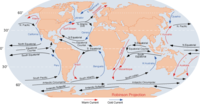
Photo from wikipedia
Repeat glider sections obtained during 2014–2016, as part of the Overturning in the Subpolar North Atlantic Program, are used to quantify the circulation and transport of North Atlantic Current (NAC)… Click to show full abstract
Repeat glider sections obtained during 2014–2016, as part of the Overturning in the Subpolar North Atlantic Program, are used to quantify the circulation and transport of North Atlantic Current (NAC) branches over the Rockall Plateau. Using 16 glider sections collected along 58∘N and between 21∘W and 15∘W, absolute geostrophic velocities are calculated, and subsequently the horizontal and vertical structure of the transport are characterized. The annual mean northward transport (± standard deviation) is 5.1 ± 3.2 Sv over the Rockall Plateau. During summer (May to October), the mean northward transport is stronger and reaches 6.7 ± 2.6 Sv. This accounts for 43% of the total NAC transport of upper-ocean waters (σO < 27.55 kg/m 3) estimated by Sarafanov et al. (2012, https://doi.org/10.1029/2011JC007572) along 59.5∘N, between the Reykjanes Ridge and Scotland. Two quasi-permanent northward flowing branches of the NAC are identified: (i) the Hatton Bank Jet (6.3 ± 2.1 Sv) over the eastern flank of the Iceland Basin (20.5∘W to 18.5∘W) and (ii) the Rockall Bank Jet (1.5 ± 0.7 Sv) over the eastern flank of the Hatton-Rockall Basin (16∘W to 15∘W). Transport associated with the Rockall Bank Jet is mostly depth independent during summer, while 30% of the Hatton Bank Jet transport is due to vertical geostrophic shear. Uncertainties are estimated for each individual glider section using a Monte Carlo approach, and mean uncertainties of the absolute transport are less than 0.5 Sv. Although comparisons with altimetry-based estimates indicate similar large-scale circulation patterns, altimetry data do not resolve small mesoscale current bands in the Hatton-Rockall Basin which are strongly needed for the right transport estimates. Plain Language Summary There is mounting evidence that heat and freshwater transported by the North Atlantic Current (eastward extension of the Gulf Stream) heavily influences European and global climate. To adequately measure this current and understand its dynamics, underwater gliders navigate over the Rockall Plateau, a remote region of the North Atlantic located more than 400 km off Scotland. These robots collect data up to a kilometer beneath the ocean’s surface and, due to their low energy consumption, can operate over thousands of kilometers for months at a time. This study analyzes 2 years of continuous ocean glider measurements in the North Atlantic and reveals two branches of the North Atlantic Current over the Rockall Plateau that we named the Hatton Bank Jet and the Rockall Bank Jet. For the first time, the monthly variability of these currents was characterized (speed and horizontal/vertical extension). These branches carry a significant portion of the upper-ocean waters transported by the North Atlantic Current (40%). This work highlights the importance of using autonomous underwater vehicles as part of an ocean observatory. In addition to monitoring the state of the North Atlantic Ocean, these underwater robots help us understand its dynamics, which impacts the European and global climate.
Journal Title: Journal of Geophysical Research
Year Published: 2018
Link to full text (if available)
Share on Social Media: Sign Up to like & get
recommendations!